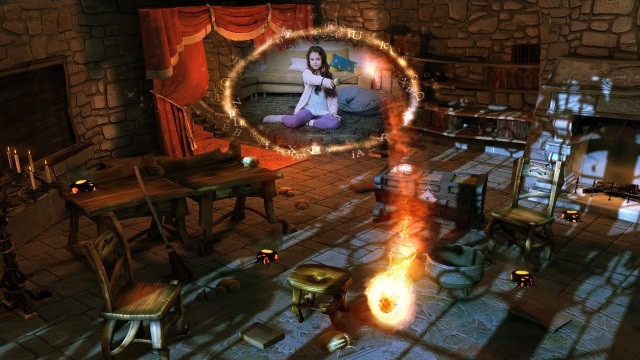This A.R. game slaps all the others in the face.
The launch title for Sony's Wonderbook: Book of Spells is like a P.R. company's wet dream. It's a Playstation Move, augmented reality, edutainment title set in the Harry Potter universe with the cooperation, support, and writing of J.K. Rowling woven directly into the game. It's like a confluence of factors designed to allow Sony to print money at the start of a new product line. It's also a damn amazing game.
The Wonderbook is the size and shape of a children's book, but every page is full of A.R. symbols that inform the PS3 the position of the pages, so that it can display the data on-screen to turn the symbols into readible pages, images, and 3D models that can be affected in real-time by the Move controller or the player themselves. In Book of Spells, it becomes a children's textbook of spells as if the child were attending Hogwarts, complete with writing in the margins by prior students who had the book before. The game divides itself into chapters, each the length of the pages in the Wonderbook itself. The potential for interactive learning is endless.
The Move controller is a wand for Book of Spells and can lift text or images off of the book where they spring to life onscreen. Ignoring the advice of a previous owner of the book, tapping a troublesome dragon causes it to spring to life and burst from the book leaving a hole in the paper where it had been. It burns the pages of the book with its breath, and the user has to physically wipe the ash from the pages to be able to read them again.
Before learning the spell in the chapter, a pop-up puppet show on the next page showcases the story behind the spell. Not only is this animated, but the whole diarama can be turned and looked at from any angle in real-time. While the story plays out, the book tests reading comprehension by asking the player to insert the correct words into some key phrases of paragraphs within the text. The correct choice continues the story.

After reading the story, the player gets to learn the spell and test it in an A.R. scene that puts the player directly into the story. The spell we learned in the demo was a flame spell and was used to burn paper beetles, butterflies, and the troublesome dragon from earlier. In the actual game, missed spells can set objects in the classroom on fire, which reduces the score the player receives from their wizard class instructor at the end of the chapter.
The game weaves in morals and life lessons directly into each chapter and looks like a great start for what could be an extensive product library aimed at children and parents looking to make learning fun. If I were eight through ten, and I saw this, I wouldn't know what to do with myself. It should be releasing for the holiday season.







